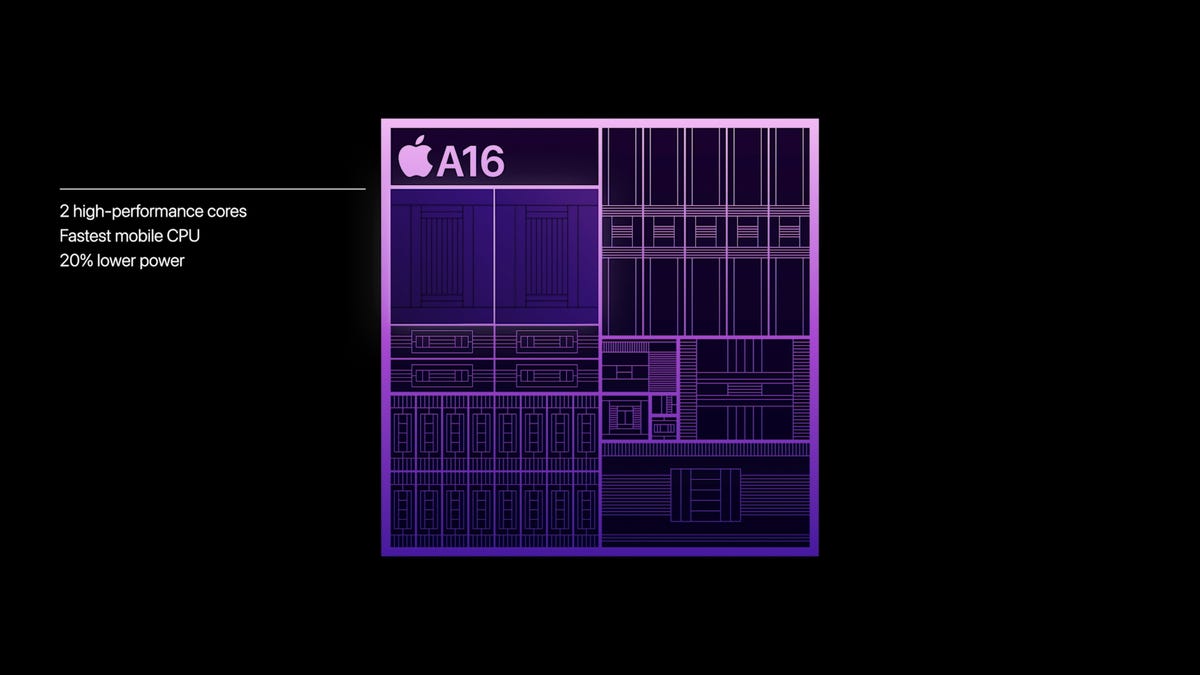iPhone 14 Pro and Pro Max Only Models to Get New A16 Chip

The new iPhone 14 Pro series uses the new A16 Bionic chip.?
Apple/Screenshot by Sarah Lord/CNET
This story is part of Focal Point iPhone 2022, CNET’s collection of news, tips and advice around Apple’s most popular product.
Apple on Wednesday unveiled the A16 Bionic, its highest-performing smartphone processor yet with 16 billion transistors, at its launch event for the iPhone 14.?
Unlike with previous processors, the A16 will only be available in Apple’s higher-end iPhone 14 Pro and Pro Max models. The more mainstream iPhone 14 and 14 Plus will make do with the A15 chip that Apple debuted in 2021.
The A16 Bionic, built on a 4-nanometer process, sports a faster six-core CPU. That’s the same combination of two powerful and four efficient cores Apple has used for years. Apple didn’t say how much faster the A16’s high-performance cores are compared with those on the A15, but they use 20% less power. For the four efficiency cores, Apple didn’t offer any comparisons to the A15.
Apple event: Full coverage
- Everything Apple Announced: iPhone 14, Apple Watch Series 8 and More
- iPhone 14 and 14 Plus Start at $799 Featuring Camera Updates
- Apple’s New AirPods Pro 2 Get Better Noise Canceling
- iPhone 14 Pro, Pro Max Get New Notch with Dynamic Island Feature
- Apple Watch Series 8 Unveiled
The 16-core neural engine, designed to accelerate increasingly important artificial intelligence software, can perform almost 17 trillion operations per second and power the iPhone’s advanced computational photography. The five-core GPU has 50% more memory bandwidth to better support graphic-intense games. The A16’s new display engine allows for a 1Hz refresh rate for lower battery consumption, the always on display, higher peak brightness and smoother antialiasing for blending graphics.
You may not notice new chip performance directly, but it’s key to delivering new abilities, like the iPhone 14 Pro’s advanced photo and video processing. The act of taking a photo exercises the A16’s CPU, GPU, image processor and neural engine, cranking out up to 4 trillion operations per photo to deliver a photo.
The new chip is important both to Apple’s ambitions and to iPhone owners. Apple’s iPhone chips have maintained a significant performance lead over rivals, helping to ensure iPhones are fast not just for its customers but also for the developers who are crucial to bringing apps to the phones. The A-series line is now the foundation for Apple’s M-series processors used to power its Macs.
Apple unveiled the new processor at its iPhone 14 launch event, a major moment on the annual technology calendar. The iPhone itself is an enormous business for Apple, but it’s also a foundation of a huge technology ecosystem deeply embedded into millions of peoples’ lives, including services like iCloud and Apple Arcade and accessories like AirPods and Apple Watches.
Still, the A16 also shows how hard it’s become make progress is in the semiconductor business. Two years ago, Apple’s A14 was early to the latest chipmaking technology, the 5-nanometer process from chip foundry Taiwan Semiconductor Manufacturing Co.
The A15 used the 5nm process too. And this year, the A16 uses a 4nm process — not TSMC’s newer 3nm process. The 3nm process offers better performance and miniaturizes circuitry so that more features can be crammed onto a processor, but is only now entering mass production, too late for the latest iPhone.
Qualcomm, the top chipmaker for the Android smartphones, acquired startup Nuvia in an attempt to give its processors a big speed boost. However, chip design firm Arm, which licenses processor technology to Apple, Qualcomm and many others, sued Qualcomm in August, saying Qualcomm tried to transfer Nuvia’s technology licenses without Arm’s consent.